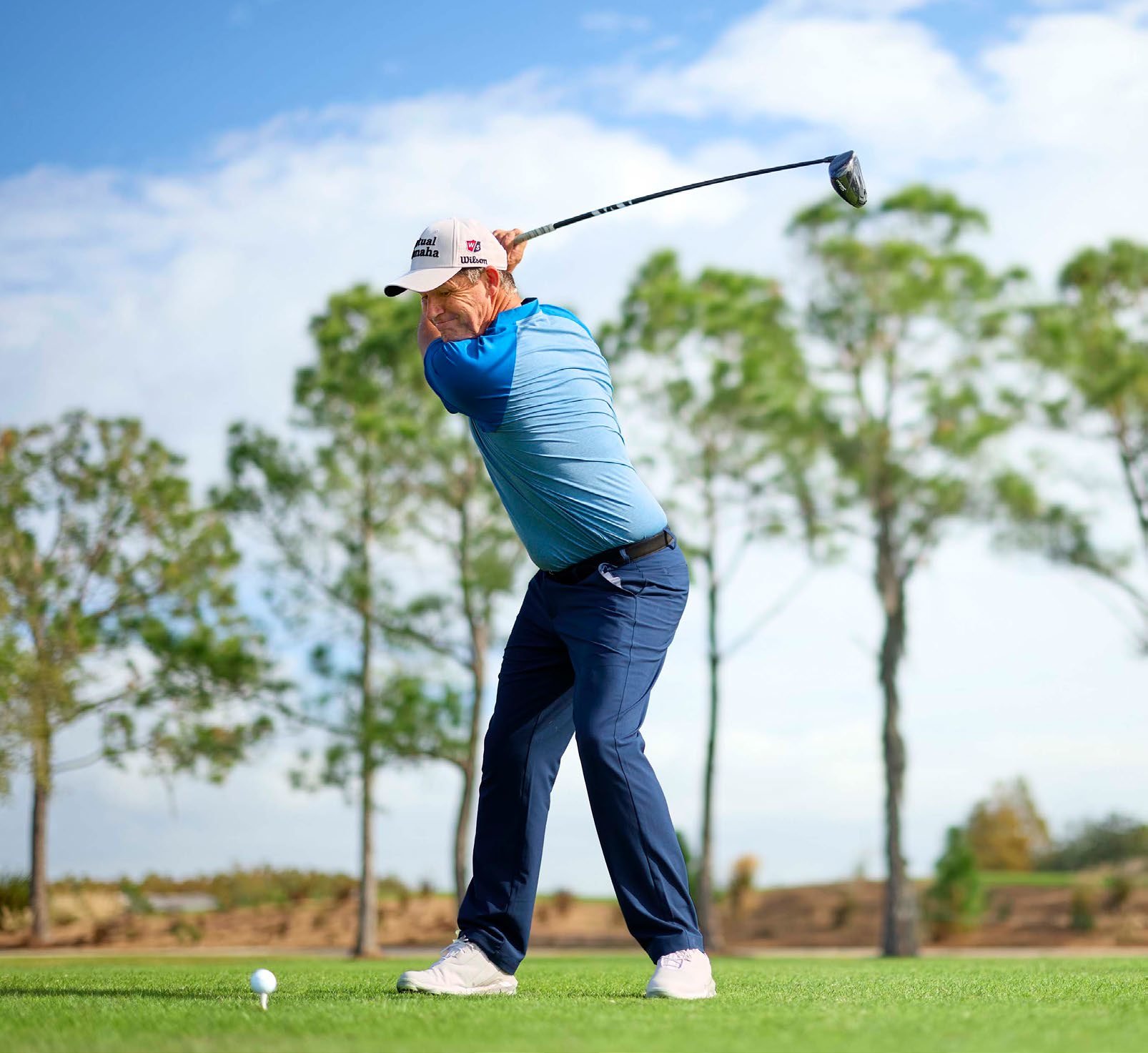


PLAY IN PRO-AMS ALMOST EVERY WEEK, AND MEET LOTS OF GOLFERS
about my age – I’m 52 – who love the game and have the goal of retiring soon and playing more golf. The problem is many can barely carry the ball 180 metres. In 15 years, they might struggle to fly it 150 – and if that happens, they’re going to get frustrated and likely end up hating the game at a point in life when they should be enjoying it more than ever. It’s one of the reasons I created the YouTube Channel, “Paddy’s Golf Tips.” I wanted to offer some hope to golfers who are getting older and not hitting the ball the way they once did. > I felt that way about my game, too, so I did something about it. Working hard on speed with my coach, Michael Jacobs, I’m now swinging faster and hitting it further in my 50s than I was in my 30s – seriously! Here, I’ll share some of the things I learned about how to combat the negative aspects of aging. If you’re over 50, the time to train is now. If you sit back, you risk becoming that golfer who only carries it 160. It’s the old “use it or lose it” adage, and it’s so true when it comes to training those fast-twitch muscles necessary for speed. Read on, and I’ll help you regain some of that pop you lost off the tee. – WITH LUKE KERR-DINEEN
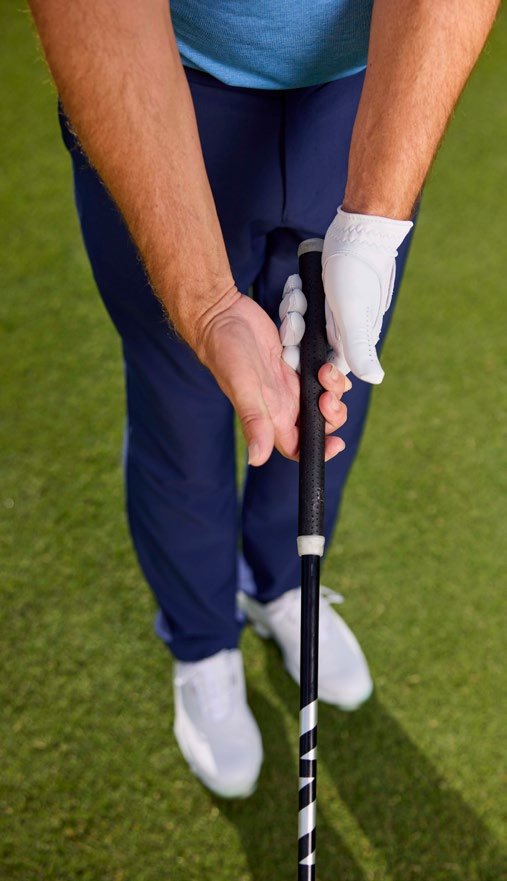

DRILL:
GRIP THE HANDLE
MORE IN YOUR FINGERS
Grip changes are universally loathed, but this adjustment is crucial for speed. Rest the handle more in the fingers of both hands (far left) instead of mostly in your palms. This provides a lot of freedom when you swing. To test it, hold the club in the fingers of your gloved hand and let your arm hang by your side (left). Note how you can move the club with just your hand and wrist. Your arm doesn’t have to move like it does when you rest the club in your palms.
Also experiment with grip styles that promote more suppleness. I use a “double overlap.” The pinky and ring finger of my right hand are on top of my gloved hand. Give it a try.
FEEL:
STAND TALLER AND
MORE RELAXED
How you address a ball greatly impacts your ability to swing the club fast and free.
One thing I learned a few years ago as I chased more speed, especially off the tee, is that you’re way better off feeling relaxed at setup than if you stand rigidly over the ball – which is how I was taught as a kid to get into my address posture.
I now stand more upright with my rear end tucked underneath my slightly rounded shoulders (right). To stay loose, I’m always moving before I swing, especially my feet.
Standing taller and more relaxed when you address the ball will help the fluidity of your swing. Getting all tense and hunched over is a real speed killer.
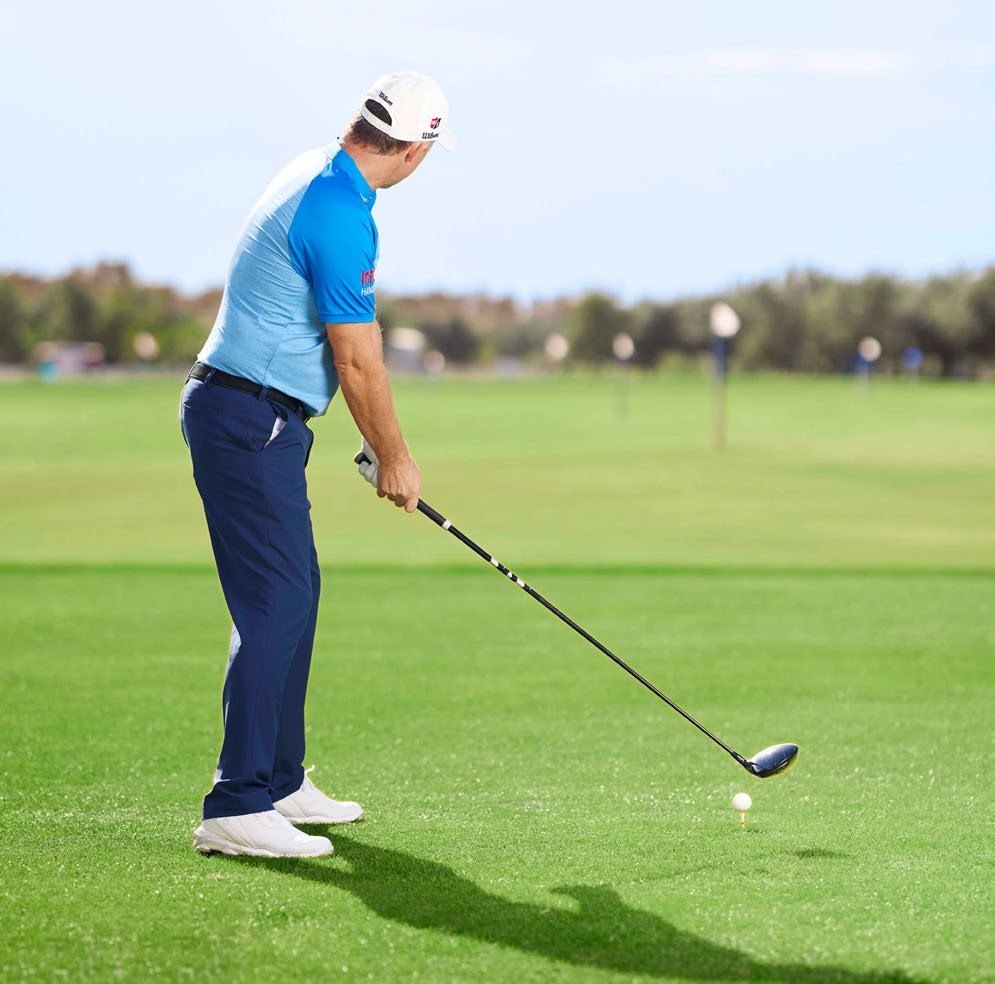
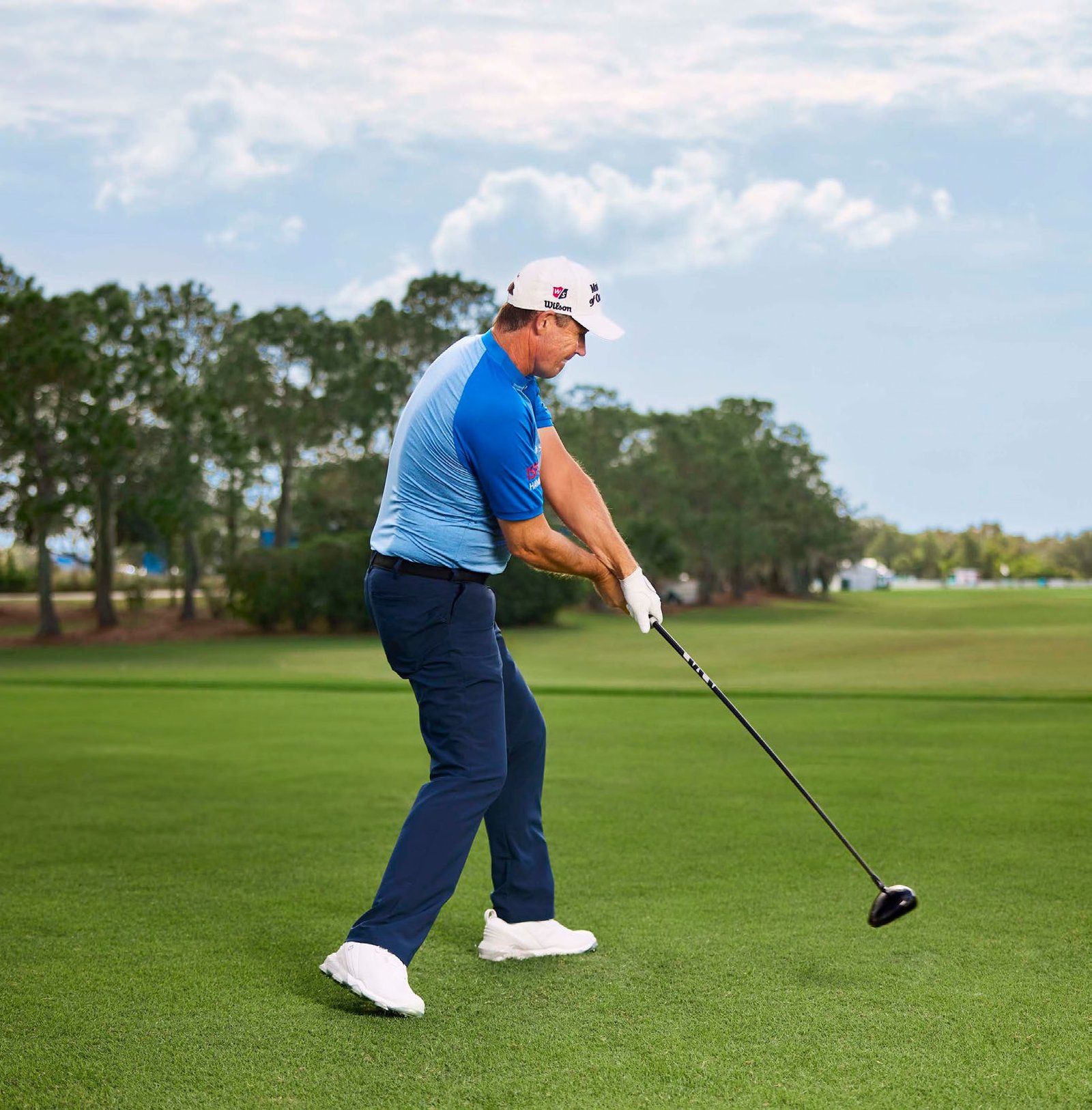
DRILL:
DRILL:
SWING CROSS-HANDED TO FEEL HOW TO TRANSFER ENERGY
SWING CROSS-HANDED
TO FEEL HOW TO TRANSFER ENERGY
In Ireland, I grew up playing the Gaelic sport of hurling. In that sport, I grip the hurley with my left hand lower than my right, the opposite of how you’re supposed to hold a golf club. I got used to that grip, so now I’ll often make my practice golf swings cross-handed (above) to work on more speed. Let me explain why.
You can generate all the power in the world with your arms and body, but that doesn’t matter if you can’t transfer it out to the clubhead. Swinging cross-handed helps you feel that energy transfer. What it does is force the club to release past your hands as you swing through the impact zone. You’re releasing all the energy into the ball so none of it is wasted.
When you get older and can’t move your body like you once did, relying on this release – using your hands to give the ball a good whack – becomes much more important. This drill helps train that.

FEEL:
TURN OFF YOUR
BRAIN TO UNLOCK YOUR
INNER ATHLETE
Golfers sometimes get lost in swing tips and thoughts, focusing on the right positions instead of remembering an important aspect of hitting golf shots: You want to feel as athletic as possible and swing without much, if any, conscious thought. We instinctively know how to move to do all sorts of things, but in golf, our brain often gets in the way.
To unlock your body and get in more of an unrestricted state, it helps to perform other dynamic motions. For example, a right-hander who swings left-handed has no frame of mind to interfere with the raw movement. Athleticism takes over. Another way to free yourself is by casually throwing golf balls onto the range (left). You’ll feel that stretch in your arms and body as you wind up, that big step towards the target before you throw, and an unwinding of the torso and hips around your posted leg as you release the ball – that move is just like an athletic golf swing!
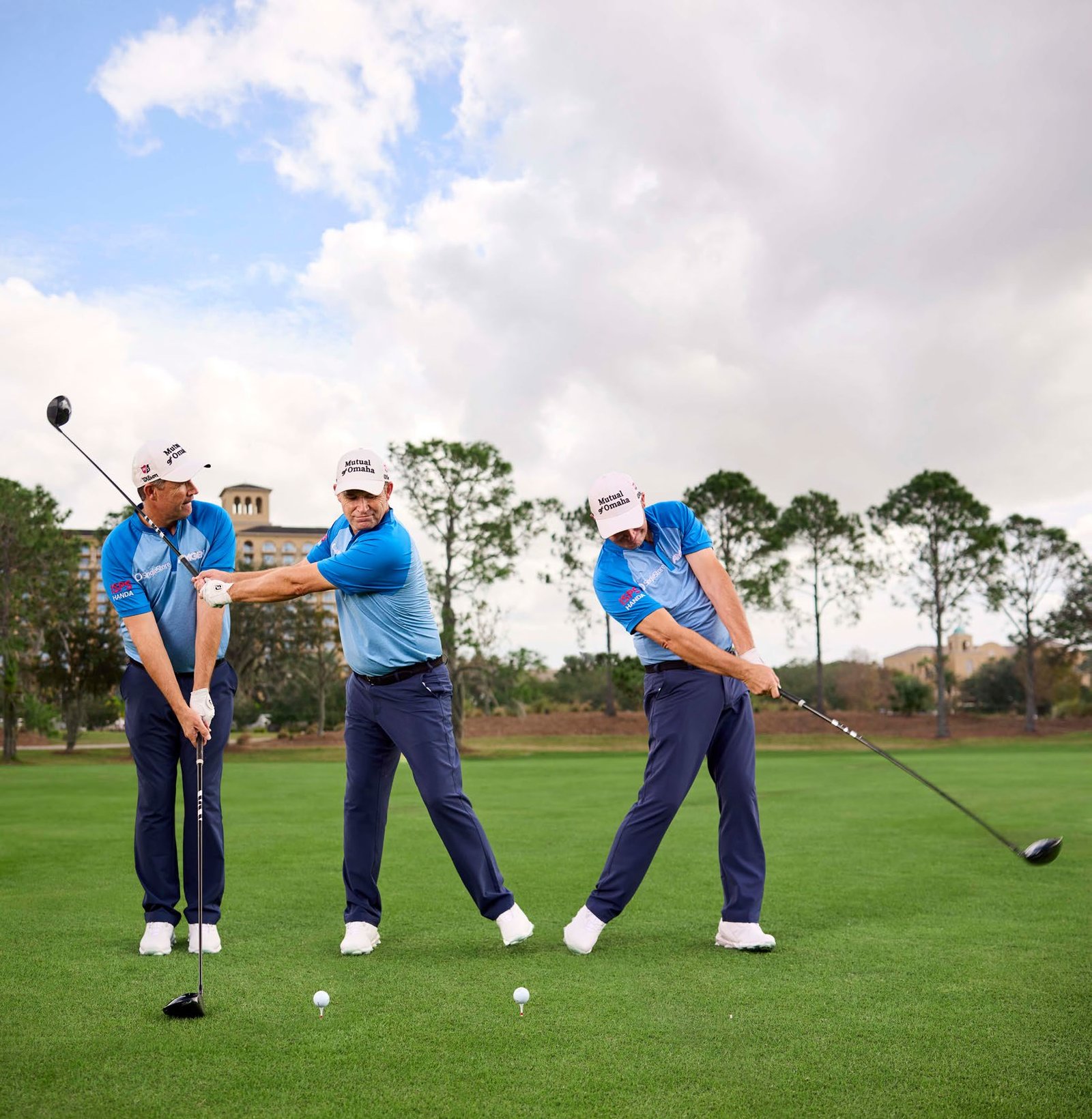
DRILL:
DRILL:
TAKE A STEP TOWARDS BIGGER DRIVES
TAKE A STEP TOWARDS
BIGGER DRIVES
I’ve played entire tournaments stepping laterally towards the target as I swing. I even did it in the US Open at Winged Foot in 2006. Every time I was in heavy rough, I’d take a little step with my left foot on my way through. It gave me more speed and power in that deep, thick grass.
Side-stepping like this helps if you struggle to transfer weight into your lead foot at the optimal time. (Tip: It should happen in your swing a little sooner than you might think.) I have a good drill to improve your timing.
Tee up a ball and address it with your feet together about a stride-length behind where you normally would (above, left). Stay that way as you take the club back but before you reach the top of the swing, take a big step towards your target (above, centre), plant that foot, and then swing through (above, right).
This drill might feel strange initially, but it’s great for more power.
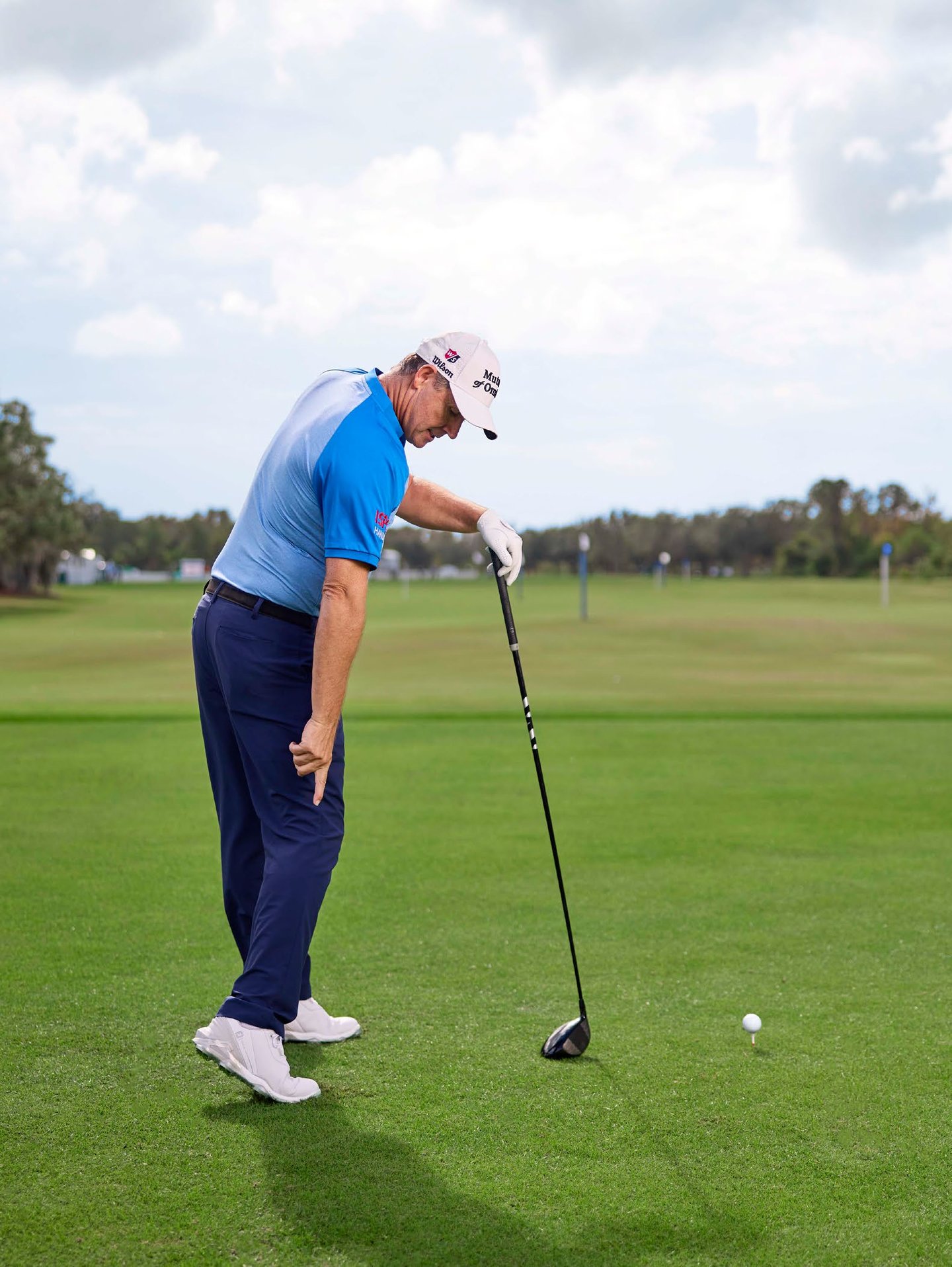
FEEL:
GET OFF THE
BLOCKS LIKE A SPRINTER
I can tell how good most golfers are before they even swing. You just have to watch them move. However, I will say that bad golf swings aren’t always the result of aging or poor physical fitness.
Nowadays, many amateurs are getting their golf instruction on social media from people they’ve never heard of. A common piece of bad advice is to stay down and swing in the same posture you started in at address. When I see golfers trying that, they might manage to stay down, but they can’t move or turn freely. They’re in big trouble.
Instead, I’d much rather see you rising up as the club moves through impact. You want to squeeze your glutes and thrust up with your legs, which in turn whips the club through impact. As you swing down, use your trail foot to push off the turf like a sprinter coming out of the blocks (left). That’s how you pick up some serious swing speed and hit one way down the fairway past those cocky kids!
WHAT’S IN HIS BAG
Christo Lamprecht stands tall at 6ft 8in (the tallest golfer to compete in The Open), which can make club fitting a bit challenging. During The Open he said he went through three sets of clubs in an 18-month period between the ages of 14 and 15 because of multiple growth spurts, adding half an inch to his clubs each time.
Because of a rule that went into effect on 1 January 2022, his driver is limited to 46 inches in length. All his irons, except his 3-iron, are 1.5 inches longer than standard and he uses a 43-inch arm-lock putter. Lamprecht also travels with two lob-wedges, one with 6deg of bounce and the other with 10. He usually uses the 6-degree club on firm courses like Britain’s links but opted for the 10-degree option at Royal Liverpool.
Driver: Ping G430 LST (9deg)
3-wood: Titleist TS2 (15deg)
3-iron: Ping i230
Irons: Ping Blueprint (4-PW)
Wedges: Ping GFP (50, 54 and 60 degrees)
Putter: Ping 2021 Harwood Armlock
Ball: Titleist ProV1
